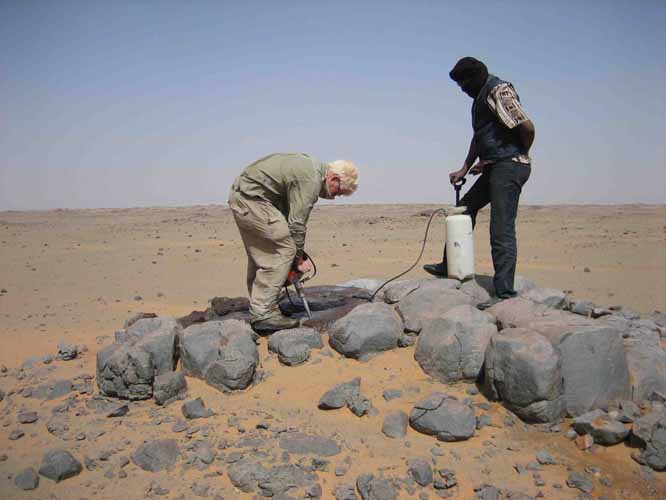

46266-AC8
The Paleomagnetism of Mesozoic Dike of Mauritania: Implications for Motion and Stability of Africa
During the reporting period the PI led an expedition to the Sahara to collect samples of Mesozoic (~200 million-years-old) dikes. These basaltic rocks may be part of the Central Atlantic Magmatic Province (CAMP), however the exact timing and paleomagnetic signature of the dikes are not well constrained. Although sampling was challenging given the harsh environment (sandstorms), paleomagnetic samples were collected as field-drilled cores (oriented with a Brunton and Sun compass) over a large area of northeastern Mauritania. Radiometric age determinations on select samples are currently underway at Oregon State University. Prior to paleomagnetic characterization, a complete rock magnetic investigation was undertaken by undergraduate and graduate students in the paleomagnetism laboratories at the University of Rochester. Magnetic hysteresis data collected with a Princeton Measurements Corporation Alternating Gradient Force Magnetometer suggest that bulk rock samples contain mixtures between multidomain and single-domain magnetic minerals. Magnetic susceptibility measured using a KLY-4S Kappabridge reveal Curie points of 570-580 °C suggesting the presence of magnetite (Fe3O4) and the absence of hematite, consistent with the apparent freshness of the bulk samples. The presence of magnetite is confirmed by a low temperature inflection point at ~-153 °C in the magnetic susceptibility data. This inflection is characteristic of the cubic to monoclinic transition in magnetite known as the Verwey transition. This transition is suppressed with oxidation and Ti substitution—thus its presence indicates that there are un-oxidized nearly pure magnetite grains in the samples. This in turn suggests high temperature oxidation upon initial cooling; textures seen in reflected light microscopic analyses and SEM studies confirm this inference.
Paleomagnetic analyses have included detailed stepwise alternating field (AF) and thermal demagnetizations using a Sapphire Instruments SI-4 demagnetizer and an ASC TD-48 thermal demagnetization device, respectively. Remanence measurements have been made with a 2G SQUID Magnetometer (housed in a magnetically shielded room) and a Geofyzika JR-5A high-speed automatic spinner magnetometer. Samples measured to date show linear decay to the origin (of orthogonal vector plots of the remanent magnetization) after the removal of a low coercivity, low unblocking temperature overprint. The rock magnetic characteristics and preliminary paleomagnetic data suggest that the dikes from Mauritania are high-resolution recorders of the Triassic-Jurassic geomagnetic field. Comparison of the paleomagnetic data from these rocks with results from southern Africa should allow us to investigate the coherency of the African continent coincident with rifting that formed the Atlantic Ocean.

PI drilling Mesozoic dike in Mauritania
for paleomagnetic samples.